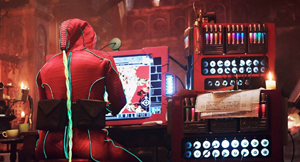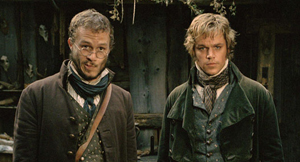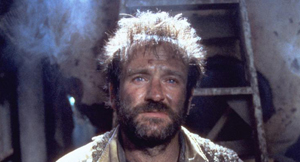The history of The Zero Theorem can be traced back to 1999, when university professor Pat Rushin wrote a short story entitled The Call. Rushin showed it to a filmmaker friend, who suggested that he turn it into a screenplay. Rushin completed the script and submitted it to Project Greenlight, a television series that Matt Damon and Ben Affleck produced. It made the top 250, and then the script ended up with Alicia Marotto at the Zanuck Company. She took it to Dean Zanuck, who guided the script to its production at the end of 2012.
Rushin teaches creative writing in the English Department at the University of Central Florida in Orlando. He has earned degrees from the University of Dayton (1976), the Ohio State University (1979), and the Johns Hopkins University (1982). His book of short stories, Puzzling Through the News, was published by Galileo Press, and his stories have appeared in various literary magazines. His short story Speed of Light was made into a short film, called No Ordinary Sun, in 2004. The Zero Theorem is Rushin’s first feature film script to be produced. | Pat Rushin on set in Carol Park in Bucharest |
Phil Stubbs: What is your role at University of Central Florida, and what are its benefits and enjoyments?
Pat Rushin: I teach creative writing in the English Department at UCF – have done so for the past 30 years – and for the past 15 years or so, I’ve taught a lot of online classes. So, like Qohen Leth, I sit in front of a computer screen much of the day “crunching entities”. The benefits? I’m my own boss. I say when and how I work. Although I have a bunch of bosses a.k.a. students who don’t let me rest long between classes. The enjoyments? I get to read and write all the livelong day. Pure bliss for me. 35 years ago I was a factory worker who didn’t even know how to spell professor properly. Now I are one. Um, that’s a joke, I hope. What influences or experiences did you draw on when imagining the story?
The Zero Theorem was inspired by a novella I wrote called The Call, and that novella was inspired by the Book of Ecclesiastes, which is the lament of a man who has lived a full and otherwise satisfying life wondering what it all means if this is all there is, if there is no afterlife. I attempted to adapt that novella into a screenplay, but the screenplay form took me far afield from where I’d started. When Terry Gilliam got involved in the project, I’d already gone through six or seven major rewrites of the script for the Zanuck Company. Terry asked to see the first draft of the script, and he also read the novella. He said to me, “Pat, Hollywood has a way of taking a good story and fucking it up.” I will forever love Terry for that attitude. He read that early draft, because of course I didn’t show him the FIRST, which was absolute shit, I showed him the first rewrite I’d done for the Zanucks, and he suddenly had us working on a concordance of the most recent draft with that early draft. I was absolutely thrilled. We were cherry-picking the best parts from both versions. Can you describe the process of how your script was amended prior to shooting?
I seem to be anticipating your questions in my previous answers. The process was pure joy for me. Pure joy. Who wouldn’t want to have Terry Gilliam taking your story seriously? As I said, Terry and I came up with a concordance of early draft and late draft. That in itself was a joy I can’t describe. I mean. I’d already rewritten this thing how many times? But suddenly I was working with a kindred spirit, not to mention a hero, who understood my ideas and presented his own and treated me with absolute respect. It felt so good knowing this was a Terry Gilliam movie. That was initially. Then Terry really got into it. Picturing it. A party scene I wrote that was simply: INT. PARTY – NIGHT became this wild and thematically significant PARTY I’d never imagined. I was there for the shooting of it, all these ear-budded people dancing to their i-pods and i-pads, David Thewlis in a Tigger costume, Melanie Thierry striking up a fake cigarette and blowing fake smoke in Qohen’s face… So, so sweet. The dialogue remains the same as I wrote it. The action improves. Terry Gilliam, as you might have suspected, is a fucking genius. How did it feel to see your ideas solidly constructed?
Good. Better than good. As I said, Terry made this script his own, but he always asked me first, gave me fair warning. Is this OK? He’s a real gentleman. Can you describe your experiences on the set and appearing in the action?
When I showed up Monday morning for the park scene, Terry took one look at me and said, “Get this man to wardrobe!” He did the same with my wife, and we ended up working two days as extras, walking around in the background, sitting on a park bench in the background. Terry said that as long as I was sitting, I might as well do some writing. He needed some messages that Mancom would scroll across the screens at the work stations – Mancom Motivationals we called them. Things like “Pedal harder! Unemployment’s catching up with you!” So in the only scene where my wife and I survived the cutting room floor, you can see us sitting in the background, Mary reading London’s Future News and me, briefcase propped on my lap, writing Mancom Motivationals. I think Terry liked the postmodern irony of the writer actually writing on film. What are your views of the completed picture?
Actually, I think it’s pretty brilliant. Everyone in the world should see it. Has your success with this script changed anything for you at the University?
People have been taking notice. I’ve been interviewed by several papers here, as well as the alumni magazine, and we recently had a screening of Zip-T here on campus for the Florida Writers Conference, where I got to do a Q&A after the movie. The recognition is nice, but I think I need to get busy on the next script! | Pat Rushin with his wife Mary |
|


















